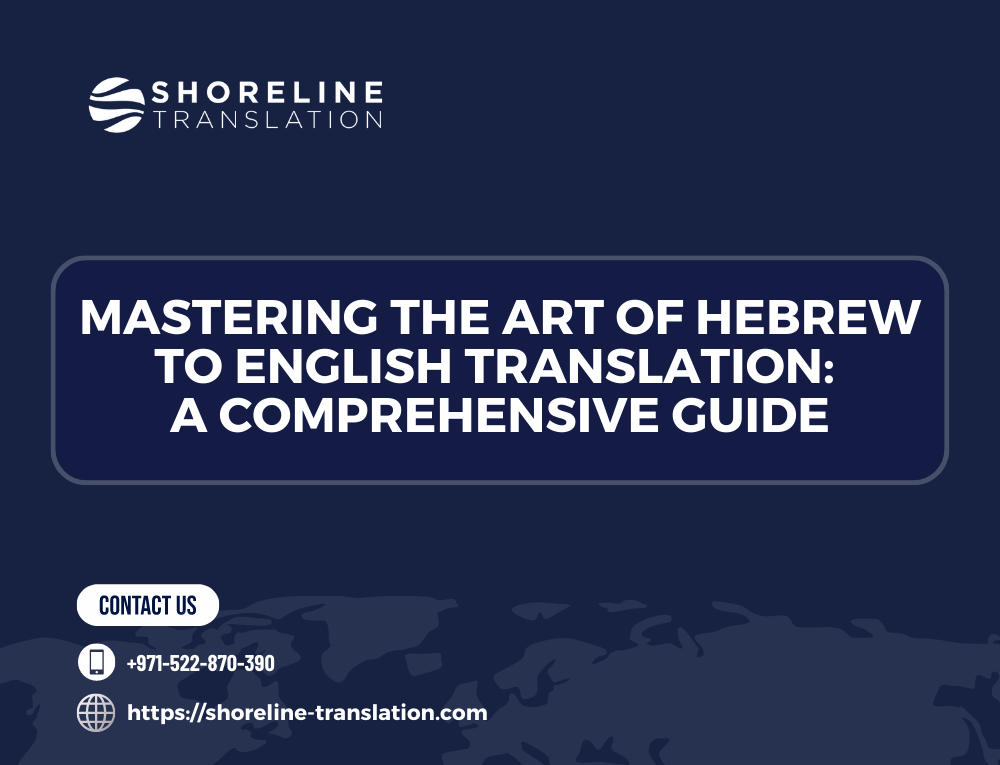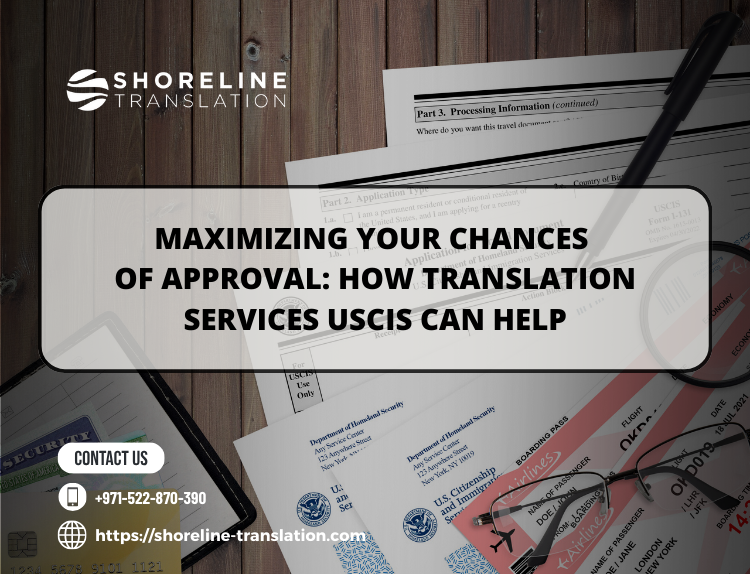Table of Contents
ToggleMastering the Art of Hebrew to English Translation: A Comprehensive Guide
Are you fascinated by the Hebrew language and its rich cultural heritage? Do you find yourself captivated by the beauty of Hebrew texts, but struggle to fully comprehend their meaning in English? If so, then this comprehensive guide to mastering the art of Hebrew to English translation is for you!
Hebrew, one of the oldest languages in existence, has a diverse and complex structure that can pose challenges even for experienced translators. However, with dedication and practice, anyone can develop proficiency in translating from Hebrew to English.
In this blog post, we will delve into the fundamentals of Hebrew grammar and vocabulary, explore techniques for accurate translations, discuss common pitfalls to avoid, and provide valuable resources and tools for enhancing your skills. Whether you’re a professional translator or simply an enthusiast seeking a deeper understanding of Hebrew literature or religious texts – this guide has something for everyone.
So let’s embark on this exciting journey together as we unlock the secrets behind effective Hebrew-to-English translation!

Understanding the Fundamentals of Hebrew
Hebrew, one of the oldest languages in existence, holds a rich history and cultural significance. Whether you’re embarking on a journey to learn Hebrew or seeking to translate it into English, understanding its fundamentals is essential.
To grasp the basics of Hebrew, start by familiarizing yourself with its alphabet. Unlike English, which uses 26 letters, Hebrew has 22 characters known as consonants. Additionally, vowels are represented by dots and dashes placed beneath these consonants.
Next, delve into grammar rules and sentence structure. Like many Semitic languages, Hebrew follows a subject-verb-object (SVO) word order. Nouns have gender (masculine/feminine), number (singular/plural), and state (definite/indefinite), all crucial for accurate translation.
Furthermore, acquiring vocabulary is vital for language proficiency. Begin with common words like greetings and daily activities before expanding your lexicon to encompass more complex terms specific to various domains such as business or medical fields.
Last but important in mastering Hebrew’s fundamentals is familiarity with verb conjugation patterns. Verbs change according to tense (past/present/future), person (1st/2nd/3rd), gender (masculine/feminine), and number(singular/plural). Developing a strong foundation in verb forms enables precise translation from Hebrew to English.
By comprehending these fundamental aspects of the language, you’ll be well-equipped for successful navigation through the intricacies of translating between Hebrew and English!
Developing Language Proficiency
Becoming proficient in any language takes time, effort, and dedication. The same holds for Hebrew to English translation. To master the art of translating between these two languages, it is essential to develop your language proficiency in both Hebrew and English.
Immerse yourself in the Hebrew language by listening to native speakers or watching movies with subtitles. This exposure will help you familiarize yourself with the pronunciation and intonation of words. Additionally, reading books, newspapers, and online articles in Hebrew can expand your vocabulary and improve your understanding of sentence structure.
Practice regularly by engaging in conversations with native Hebrew speakers or finding language exchange partners online. Speaking the language helps improve fluency and allows you to gain a deeper understanding of cultural nuances that may not be apparent through written text alone.
Consider enrolling in formal language courses or hiring a tutor who specializes in teaching Hebrew. These professionals can provide valuable guidance on grammar rules, syntax patterns, and idiomatic expressions specific to the Hebrew language.
Last but important is perseverance; learning a new language requires consistency over an extended period. Make it a habit to set aside dedicated time each day for studying and practicing both spoken communication and written comprehension skills.
By constantly honing your proficiency levels through exposure, practice, and formal instruction when necessary combined with unwavering dedication towards consistent learning efforts – you can effectively bridge the gap between mastering Hebrew to English translation!
Translating Hebrew Idioms and Expressions
Translating Hebrew Idioms and Expressions can be a challenging task for any language professional. Idioms are figurative expressions that have a meaning beyond the literal interpretation of their words. They often carry cultural connotations and may not have an equivalent in English. To accurately translate these idioms, it is crucial to understand their cultural context.
One way to approach translating Hebrew idioms is by looking for similar expressions or metaphors in English that convey the same meaning. This requires creativity and flexibility, as direct word-for-word translations may not capture the essence of the original idiom.
Another technique is to explain the meaning of the idiom within the translated text itself, using additional phrases or sentences. This helps readers who are unfamiliar with Hebrew idioms understand the intended message.
It’s also important to consider regional variations when translating idiomatic expressions. Different regions within Israel may have unique idioms that reflect their local culture and dialects. Familiarizing yourself with these variations will ensure accurate translations for specific audiences.
Mastering the art of translating Hebrew idioms takes time and practice. It requires a deep understanding of both languages and cultures involved, as well as extensive knowledge of common expressions used in everyday speech.
Overcoming Challenges in Hebrew to English Translation
Translating from Hebrew to English can present some unique challenges. The two languages have different structures, grammatical rules, and cultural nuances that must be taken into account. However, with the right strategies and techniques, you can overcome these obstacles and produce accurate translations.
One of the main challenges in Hebrew to English translation is dealing with idioms and expressions. These linguistic gems can often lose their meaning when translated directly. It requires a deep understanding of both languages to find equivalent expressions or phrases that convey the intended message accurately.
Another challenge lies in finding suitable equivalents for certain words or concepts that may not exist in one language or another. This requires extensive research and a strong command of both Hebrew and English vocabulary.
Cultural differences also pose a challenge when translating between these two languages. Certain references or metaphors may need to be adapted to make sense within the target culture without losing their original essence.
Maintaining consistency throughout the translation process can be difficult due to variations in style, tone, or register between Hebrew and English texts. It’s important to pay attention to context and ensure coherence while preserving the intended meaning.
By being aware of these challenges and employing various strategies like using resources (such as dictionaries, and glossaries), consulting native speakers, and conducting thorough research on specific topics/terms/phrases will help translators master this art more effectively.
Tips and Techniques for Accurate Translations
When it comes to translating from Hebrew to English, accuracy is key. To ensure that your translations are precise and convey the intended meaning, here are some essential tips and techniques to keep in mind.
It’s important to have a strong understanding of both languages’ grammar rules and sentence structure. This will enable you to accurately transfer ideas from one language to another without losing any nuances or subtleties.
Make use of context clues. Sometimes a single word can have multiple meanings depending on its usage within a sentence or paragraph. Take into account the surrounding words and phrases to determine the most appropriate translation.
Conduct thorough research on cultural references and idiomatic expressions commonly used in both Hebrew and English. Being familiar with these unique aspects of each language will help you capture their essence during translation.
Don’t hesitate to consult experts or native speakers for clarification if you encounter any challenges during the translation process. They can provide valuable insights and guidance that may improve the accuracy of your translations.
By implementing these tips and techniques into your Hebrew-English translations, you’ll be well-equipped to deliver accurate and meaningful content for your target audience!
Common Pitfalls to Avoid in Hebrew to English Translation
Translating from Hebrew to English can be a challenging task, especially when you come across common pitfalls that can hinder the accuracy and quality of your translations. It’s important to be aware of these potential stumbling blocks and take proactive measures to avoid them.
One common pitfall in Hebrew-to-English translation is a word-for-word translation. While it may seem tempting to translate each word individually, this approach often results in awkward or nonsensical sentences. Instead, focus on capturing the meaning and essence of the original text while adapting it into natural English expressions.
Another pitfall is failing to consider cultural differences between Hebrew and English speakers. Certain idioms, proverbs, or metaphors may not have an equivalent counterpart in English. In such cases, strive for creativity while maintaining the intended message.
Additionally, overlooking contextual clues can lead to misinterpretation or mistranslation. Pay close attention to the context surrounding certain phrases or expressions as they may have different meanings based on their usage within a specific conversation or text.
Neglecting proofreading and editing can result in errors slipping through unnoticed. Take the time to review your translations carefully for grammar mistakes, inconsistencies, or typos that could impact the overall clarity and professionalism of your work.
By being mindful of these common pitfalls and taking steps to avoid them during your Hebrew-to-English translation process, you’ll enhance both accuracy and fluency in your translations. Stay tuned for more tips on mastering this art!
Improving Translation Speed and Efficiency
When it comes to translating from Hebrew to English, speed, and efficiency are key. As a translator, you need to be able to work quickly without sacrificing the accuracy of your translations. Here are some tips to help you improve your translation speed and efficiency.
The organization is crucial. Start by creating a system for managing your translation projects. This can include using project management tools or simply keeping track of deadlines and progress in a spreadsheet. By staying organized, you’ll be able to prioritize tasks effectively and avoid unnecessary delays.
Leverage technology to streamline the translation process. Use CAT (Computer-Assisted Translation) tools that allow you to store commonly used phrases, terms, and translations for easy reference. These tools can also help with consistency across multiple projects.
Additionally, building a strong glossary of terminology specific to your field will save time during the translation process. Keep updating this glossary as new terms come up in your work.
Practice makes perfect! The more experience you have translating Hebrew into English, the faster and more efficient you will become. Regularly challenge yourself with different types of texts – legal documents, marketing materials, or technical articles – so that you develop versatility in your skills.
By implementing these strategies into your workflow, you’ll be well on your way toward improving both speed and efficiency in Hebrew-to-English translation!
Resources and Tools for Hebrew to English Translation
When it comes to mastering the art of Hebrew to English translation, having access to the right resources and tools can make all the difference. Thankfully, there are numerous online platforms and software that cater specifically to this language pair.
One invaluable resource for translators is bilingual dictionaries. These provide a comprehensive database of words and phrases in both Hebrew and English, helping you find accurate equivalents for your translations. Online dictionaries such as Morfix or Reverso offer quick translations with just a few clicks.
In addition to dictionaries, machine translation tools like Google Translate or DeepL can help get initial translations or understand the meaning of complex sentences. However, it’s important to remember that these tools are not always accurate and should be used with caution.
For those looking for more advanced assistance, computer-assisted translation (CAT) tools like SDL Trados or MemoQ come in handy. These programs allow you to create translation memories, store terminology databases, and work on large projects efficiently.
Staying connected with other translators through forums or social media groups can provide valuable insights into best practices and useful resources. Online communities like ProZ.com or TranslatorsCafe offer opportunities for collaboration and knowledge sharing.
With these resources at your disposal, translating Hebrew to English becomes a smoother process that enhances accuracy while saving time and effort. So go ahead – explore different tools available online today!
Shoreline Agency for Professional Hebrew Translation Services
When it comes to translating Hebrew to English, you want a reliable and efficient service that can accurately convey the meaning and nuances of the original text. Look no further than Shoreline Agency for all your professional Hebrew translation needs!
With years of experience in the industry, Shoreline Agency has built a reputation for delivering high-quality translations that meet the specific requirements of each client. Our team consists of skilled translators who are not only fluent in both languages but also well-versed in various subject matters. This ensures that we can handle a wide range of content, from legal documents to technical manuals.
At Shoreline Agency, we understand the importance of accuracy and cultural sensitivity when it comes to translating idioms and expressions. Our translators have extensive knowledge of Hebrew language nuances, allowing them to capture the essence behind these phrases and deliver an authentic English equivalent.
We pride ourselves on overcoming challenges often encountered during Hebrew to English translations. Whether it’s dealing with complex sentence structures or preserving the tone and style of the original text, our team is equipped with the skills necessary to produce accurate and natural-sounding translations.
When you choose Shoreline Agency for your Hebrew translation needs, you can expect efficiency without compromising quality. We leverage advanced software tools that aid in streamlining processes while ensuring consistency across projects. From project management to quality assurance checks, our streamlined workflow guarantees timely delivery without sacrificing accuracy.
Trust Shoreline Agency as your go-to resource for professional Hebrew translation services! Contact us today and let our team assist you in bridging language barriers effectively.
Conclusion
In this comprehensive guide, we have explored the intricacies of translating from Hebrew to English. We began by understanding the fundamentals of Hebrew, delving into its unique structure and grammar. Next, we discussed how to develop language proficiency through consistent practice and exposure.
One particularly challenging aspect of Hebrew translation is capturing the essence of idioms and expressions. We provided techniques for effectively translating these cultural nuances, allowing for a more accurate rendition in English. Additionally, we addressed common challenges that arise during the translation process and offered tips on overcoming them.
To ensure accurate translations, it is crucial to employ specific strategies and techniques. From fully comprehending context and connotation to utilizing specialized resources like dictionaries or online tools, precision can be achieved with careful attention to detail.
It’s important not to fall into common pitfalls that may result in inaccuracies or awkward phrasing in translated works. By avoiding word-for-word translations, being mindful of cultural differences, and maintaining consistency throughout the text, your translations will be more polished and professional.
Furthermore, improving speed and efficiency in translating requires a combination of practice, and familiarity with subject matter-specific terminology if applicable are essential assets for any translator aiming for success.
Fortunately, there are numerous resources available that can aid you along your journey as a Hebrew-English translator. Whether it’s digital dictionaries, glossaries, or even Translation Management Systems (TMS) Shoreline Agency provides access to high-quality linguistic experts who specialize in Hebrew translation services.
In conclusion, our guide has equipped you with valuable knowledge about mastering the art of Hebrew to English translation. By understanding its fundamentals, developing proficiency, employing effective strategies, avoiding common pitfalls, and improving speed & efficiency whilst utilizing appropriate resources – you’ll elevate your skills as an adept translator capable of delivering accurate & nuanced translations every time!





